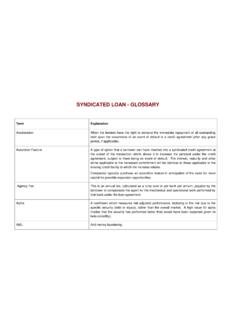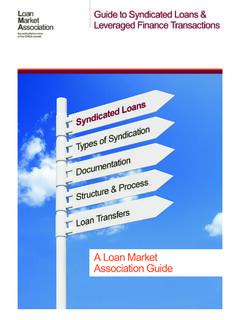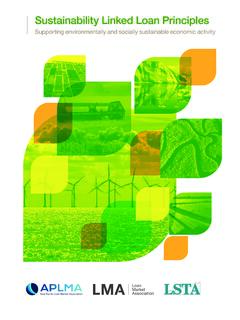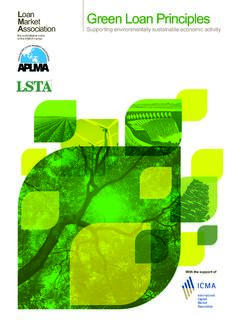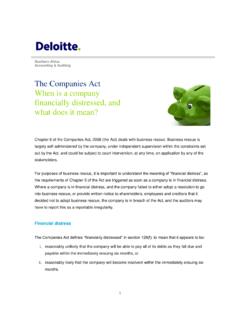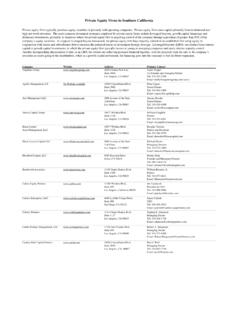Transcription of Guide to Secondary L oan Market Transactions
1 Guide to Secondary Loan Market Transactions A Loan Market Association Guide A LOAN Market ASSOCIATION Guide . A Guide TO Secondary LOAN Market Transactions . Loan Market Association 10 Upper Bank Street, London E14 5JJ. Loan Market Association 2018. Published by the Loan Market Association in August 2018. 10 Upper Bank Street, London E14 5JJ. Telephone: +44 (0)20 7006 6007. Fax: +44 (0)20 7006 3423. Email: Website: All rights reserved. No part of this publication may be reproduced, stored in any retrieval system or transmitted in any form or by any means, electronic, mechanical, photocopying, recording or otherwise, without prior written permission of the copyright holder, for which application should be addressed in the first instance to the publishers. No liability shall attach to the authors, the copyright holder or the publishers for loss or damage of any nature suffered as a result of the reproduction of any of the contents of this publication. The views and opinions expressed in this publication are the views of the authors.
2 The Loan Market Association and the authors have made every effort to ensure the complete accuracy of the text but none of the Loan Market Association, the authors or the publishers can accept any legal responsibility or liability for any error or omission in its contents. This " Guide to Secondary Loan Market Transactions " is not intended to be completely comprehensive. Rather, it seeks to provide an overview of the role of the Secondary Market in the syndicated loan Market . Most importantly, this publication is not designed to provide legal or other advice on any matter whatsoever. The Loan Market Association The Loan Market Association (LMA) is the trade body for the Europe, Middle East and Africa (EMEA). syndicated loan Market and was founded in December 1996 by banks operating in that Market . Its aim is to encourage liquidity in both the primary and Secondary loan markets by promoting efficiency and transparency, as well as by developing standards of documentation and codes of Market practice, which are widely used and adopted.
3 Membership of the LMA currently stands at over 650, covering 60+ nationalities, and consists of banks, non-bank lenders, borrowers, law firms, rating agencies and service providers. The LMA has gained substantial recognition in the Market and has expanded its activities to include all aspects of the primary and Secondary syndicated loan markets. It sees its overall mission as acting as the authoritative voice of the EMEA loan Market vis . vis lenders, borrowers, regulators and other interested parties. Guide TO Secondary LOAN Market Transactions . CONTENTS. Page Number INTRODUCTION 3. DEVELOPMENT OF THE Secondary LOAN Market 4. HISTORICAL DATA 6. Market PARTICIPANTS 7. TYPES OF DEBT 8. ANATOMY OF A TRADE 9. TRANSFER MECHANISMS 14. 2. Guide TO Secondary LOAN Market Transactions . INTRODUCTION. Syndicated loans started as a way of allowing lenders to lend large sums of money to a single borrower, where the sums involved went far beyond the credit appetite of a single lender.
4 Origination and syndication of the transaction take place in the primary Market ; it is where lenders lend directly to borrowers, with loans syndicated before the loan is made, or shortly thereafter. Following completion of the transaction, the loan becomes "free to trade", subject to the terms and conditions contained in the primary documentation. The Secondary loan Market refers to the sale and distribution of syndicated loans by lenders in the original syndicate or by subsequent purchasers of the loan. The Secondary loan Market has aided the growth of the syndicated loan Market by opening the Market to a wide variety of types of institution, including, amongst others, insurance companies, pension funds and hedge funds, fuelling an increase of liquidity within the primary and Secondary markets. The Secondary loan Market is also an essential tool that lenders use to manage their loan portfolios. The purpose of this Guide is to provide an introductory overview of the Secondary loan Market .
5 Amongst other things, this Guide shall provide a (1) target timeline for a typical Secondary loan Market transaction, including a brief explanation of the documentation which may be entered into by the parties; (2) description of the parties active in the Secondary loan Market ; and (3) description of the common methods used by lenders to transfer syndicated loan participations. 3. Guide TO Secondary LOAN Market Transactions . Section 1. DEVELOPMENT OF THE Secondary LOAN Market . The Secondary loan Market refers to the sale of loans that occurs after syndication of the original loan has been closed and allocated. It includes sales or trades of syndicated loans made by lenders in the original syndicate and those made by subsequent purchasers. A lender under a syndicated loan may decide to sell all or part of its commitment in a facility for a number of reasons, including: 1. Realising Capital: if the loan is a long-term facility, a lender may need to sell its share of the commitment to realise capital and improve its liquidity to be able to take advantage of new lending opportunities.
6 2. Risk Management: a lender may consider that its loan portfolio is weighted with too much emphasis on a particular type of borrower, geography, industry or maturity. By selling its commitment in this loan, it may lend elsewhere, thereby taking advantage of new lending opportunities and diversifying its portfolio;. 3. Regulatory Capital Requirements: a bank's ability to lend is subject to both internal and external requirements to retain a certain percentage of its capital as cover for its existing loan The Secondary loan Market is becoming an increasingly important tool for lenders to actively manage their loan portfolios to comply with regulatory capital requirements; and 4. Crystallise a loss: the lender may decide to sell its commitment if the borrower runs into difficulties, thereby realising an immediate value for its commitment, rather than holding on to a commitment where there is no guarantee that the borrower will be able to repay its debt. In addition, a lender can incur substantial costs when monitoring a borrower in financial difficulty, for example, regularly reviewing the borrower's overall financial position, reviewing its options should a borrower breach a term of the facility agreement, and analysing its rights vis- -vis other creditors.
7 Specialists dealing in distressed debt provide a Market for such loans. That said, there are a number of reasons that a buyer will want to acquire a commitment in a facility, including:- 1. Develop and expand relationships: a primary lender may wish to increase its exposure to a specific borrower, thereby increasing its profile and developing its relationship with the borrower, so that it may take on the role of agent or arranger in future syndications and/or cross-sell products to the borrower. Additionally, lenders may use the Secondary loan Market to acquire a commitment in a facility that they were not a primary party to, to build a relationship with the borrower or other financial institutions;. 1 The application of capital ratios imposed by national regulators and EC directives, specifically by way of implementation of Basel II and Basel III, requires banks to maintain capital equivalent to a certain percentage of their risk-weighted assets, so that sufficient capital is available to support the bank against losses.
8 For further information, see the LMA Guide "Regulation and the Loan Market ". 4. Guide TO Secondary LOAN Market Transactions . 2. To make a profit: traders seek to use the Secondary loan Market to make a profit, by selling on an acquired debt at a level higher than its purchase price, usually within a short space of time; and 3. To own part of the debtor company: specialist investors may buy a large portion of a borrower's debt, potentially with a view to acquiring control of the company. Alternatively, the investor may look to influence the borrower's insolvency or restructuring process. The investor may be making an investment on its assessment of the probability that the company will be successfully rescued, the ultimate aim being to profit from any subsequent upside in the value of the business. The investor may also be taking a view that the breakup value or recovery via insolvency will be sufficient to make a profit on its original investment. 5. Guide TO Secondary LOAN Market Transactions .
9 Section 2. HISTORICAL DATA. The Secondary loan Market is a private Market and data with regard to depth and liquidity is limited. There is no single data source to determine the actual volume of loans traded. Data which is available is collated on a contributor basis, via third party service providers, and reflects in the main only those Transactions concluded on an intermediated basis, those trades which have passed through trading desks, rather than those traded directly between seller and buyer without the involvement of one of the banks contributing to the data collation exercise. A 12-year overview of reported volumes, for the years 2004 to 2017, is given below. Given the limitations as described, the expectation would be that actual traded volumes are somewhat higher. Over the last 12 years traded volumes as reported have been dominated by leveraged finance. A. breakdown of reported EMEA volumes in 2016 and 2017 are given below. 6. Guide TO Secondary LOAN Market Transactions .
10 Section 3. Market PARTICIPANTS. Up to the mid-1990s, participation in the Secondary loan Market in Europe was dominated by a small number of US houses, predominantly investment banks, specialist debt traders and vulture funds, with activity focused on the distressed Market . However, from the mid-1990s onwards, institutional investors and other non-bank financial institutions increasingly looked to the Secondary loan Market to invest their money. Today's Secondary loan Market is utilised by a diverse and vast number of participants, including investment banks, commercial banks, hedge funds, pension funds, private equity funds and specialist loan brokers, each looking to transact in par, near par and/or distressed debt. In the distressed Market , the diversification and growth in the number of participants follows from the diversification and growth in the number of participants in the leveraged finance Market generally. In addition, government agencies, such as the Irish National Asset Management Agency (NAMA), were set up to buy non-performing debt as a result of the 2007-2009 financial crisis.
